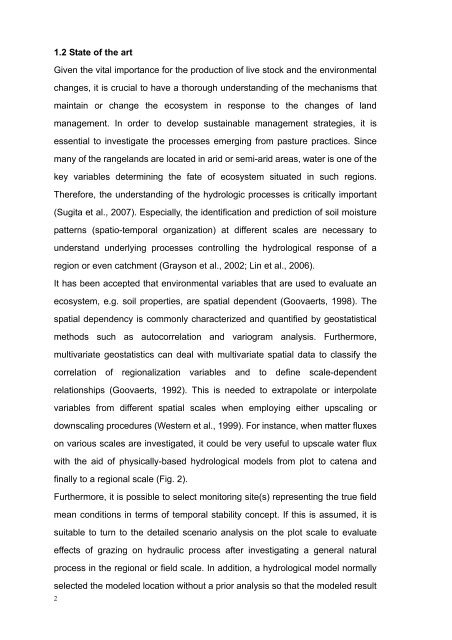SCHRIFTENREIHE Institut für Pflanzenernährung und Bodenkunde ...
SCHRIFTENREIHE Institut für Pflanzenernährung und Bodenkunde ...
SCHRIFTENREIHE Institut für Pflanzenernährung und Bodenkunde ...
You also want an ePaper? Increase the reach of your titles
YUMPU automatically turns print PDFs into web optimized ePapers that Google loves.
1.2 State of the art<br />
Given the vital importance for the production of live stock and the environmental<br />
changes, it is crucial to have a thorough <strong>und</strong>erstanding of the mechanisms that<br />
maintain or change the ecosystem in response to the changes of land<br />
management. In order to develop sustainable management strategies, it is<br />
essential to investigate the processes emerging from pasture practices. Since<br />
many of the rangelands are located in arid or semi-arid areas, water is one of the<br />
key variables determining the fate of ecosystem situated in such regions.<br />
Therefore, the <strong>und</strong>erstanding of the hydrologic processes is critically important<br />
(Sugita et al., 2007). Especially, the identification and prediction of soil moisture<br />
patterns (spatio-temporal organization) at different scales are necessary to<br />
<strong>und</strong>erstand <strong>und</strong>erlying processes controlling the hydrological response of a<br />
region or even catchment (Grayson et al., 2002; Lin et al., 2006).<br />
It has been accepted that environmental variables that are used to evaluate an<br />
ecosystem, e.g. soil properties, are spatial dependent (Goovaerts, 1998). The<br />
spatial dependency is commonly characterized and quantified by geostatistical<br />
methods such as autocorrelation and variogram analysis. Furthermore,<br />
multivariate geostatistics can deal with multivariate spatial data to classify the<br />
correlation of regionalization variables and to define scale-dependent<br />
relationships (Goovaerts, 1992). This is needed to extrapolate or interpolate<br />
variables from different spatial scales when employing either upscaling or<br />
downscaling procedures (Western et al., 1999). For instance, when matter fluxes<br />
on various scales are investigated, it could be very useful to upscale water flux<br />
with the aid of physically-based hydrological models from plot to catena and<br />
finally to a regional scale (Fig. 2).<br />
Furthermore, it is possible to select monitoring site(s) representing the true field<br />
mean conditions in terms of temporal stability concept. If this is assumed, it is<br />
suitable to turn to the detailed scenario analysis on the plot scale to evaluate<br />
effects of grazing on hydraulic process after investigating a general natural<br />
process in the regional or field scale. In addition, a hydrological model normally<br />
selected the modeled location without a prior analysis so that the modeled result<br />
2


